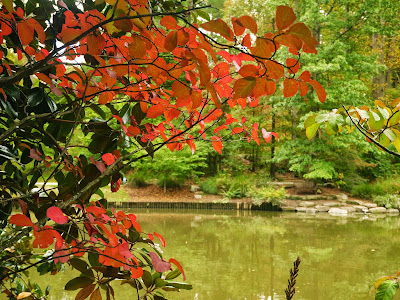By Erika Zambello
It's that time of year again. There's a chill in the air, pumpkins on the porch, and costumed little kids parading around their living rooms in preparation for Halloween. Duke Gardens is also beginning to undergo the signature seasonal changes.
Born and raised in Maine, I'm experiencing my first Southern fall. In the Northeast, when the trees begin to turn snowy is just around the corner, and the earth becomes brown and bare. North Carolina, however, is proving to be a different story altogether.
As in Maine, the leaves are turning gold, orange and red. Here at Duke Gardens, the color is just beginning to emerge, flanked by the remaining green leaves. Though the paths are clear, my favorite part of fall is straying to the trail borders and purposefully treading on leaves, hearing that oh-so-perfect crackle.
The major difference between Maine and North Carolina? While flowers in the north would be dead or in hibernation, Duke Gardens has thousands of blooms in every imaginable color. For the first time in my life, I can see the gold and red of the leaves above, coupled with the bright pastels of the flowers below. I'm just in awe of all the color.
 |
| Tea rose (Rosa x. odorata) |
I'm especially in love with the wood ducks and Chinese mandarin duck. I came upon two of them resting beside each other, and couldn't help but think that they are the perfect metaphor for the changing seasons. The forest green and brown of the Wood Duck gives way to the bright orange and red hues of the Chinese mandarin duck as they stand together on the wooden poles in the Culberson Asiatic Arboretum's pond.
If you haven't already, enjoy the beautiful weather and check out the beginning of fall foliage here at Duke Gardens. Leaf peeping and flower gazing--what could be better?
 | |||
| Ginger lily (Hedychium 'Moy Giant') |
.jpg)













.jpg)

.jpg)
.jpg)
.jpg)



